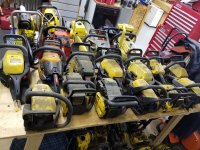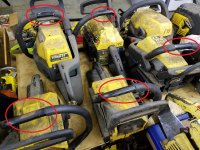eg served his time as a Fitter and Turner at BHP in Newcastle, completed Tool
Making at Technical Collage and later worked as a Leading Hand at Stewart and
Lloyds. His knowledge as a machinist and engineering allowed him not only to design
and manufacture karts from the ground up, but able to work with the very fine
tolerances required in modifying small motors to gain maximum performance.
Reg Massie, along with the support of his wife Fay designed and manufactured Karts
during the early to late 1960’s from his showroom and workshop at 114 Maitland Road
Islington.
The earliest design was the Massie Dirt Kart, which he designed and manufactured
with his brother Royd Massie. As the dirt tracks were replaced by hot mix and tyres
changed from grooved to slick, a new model Massie 85 Kart was designed weighing
87lb and powered by a part reed valve and piston induction Mac10 engine.
To improve performance, the Massie 85 was completely redesigned and rebuilt by Reg
Massie and brother in law Max Gleeson to produce the Massie Escort. The Escort had
new bucket seats, improved lighter frame and steering. All components of the Massie
Karts were manufactured and machined in Reg’s workshop or locally. To reduce
weight, the disc brakes, wheels and many other parts were cast from aluminium at a
local foundry in Wickham.
Following the introduction of the American McCulloch Kart engine, Reg soon
discovered they offered a wider scope for increasing performance as they had accessible
transfer ports that allowed for easy modification by enlarging and reshaping using
fiberglass resin. The McCulloch had six transfer ports, Reg added another three
opposite the exhaust to significantly increased performance. Enlarging the ports would
deliver three times the air fuel mix. Another simple modification was free-porting the
exhaust.
The McCulloch engines were fitted with reed valve inlets and diaphragm carburettors
with high and low speed mixture screws allowing fine-tuning during the race. Reg also
fitted the engines with triple carburettors. At the time he used 100% alcohol fuel.
Another way Reg increased performance was to advance the timing and bypass the
ignition points with a switch giving 27 degrees advance, once the motor reached certain
rpm, known as Maverick spark.
Reg and Max improved on this by fitting a second set of ignition points, when switched
over giving 48 degrees advance peaking at 23,000 rpm. The downside was that due to
the engine firing halfway up the stroke, if the driver didn’t switch back before the revs
dropped, the con-rod would disintegrate. This was in the days prior to electronic
ignition. Hi to smith, the only thing I found on the internet about maverick spark









